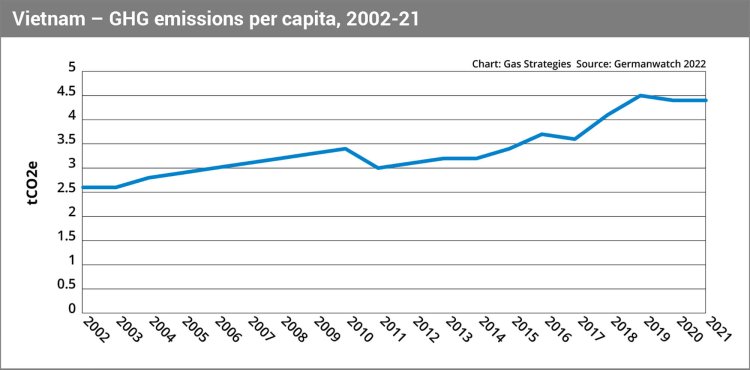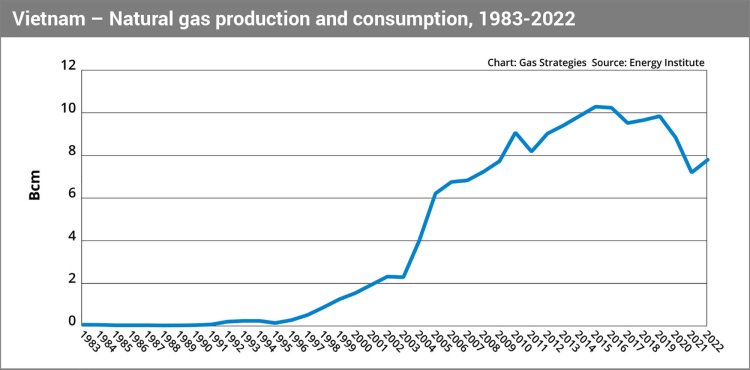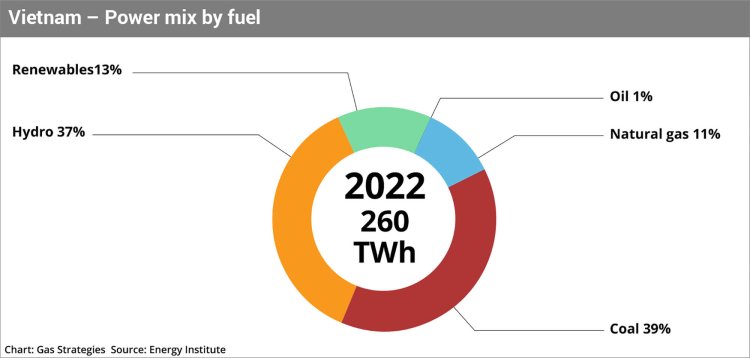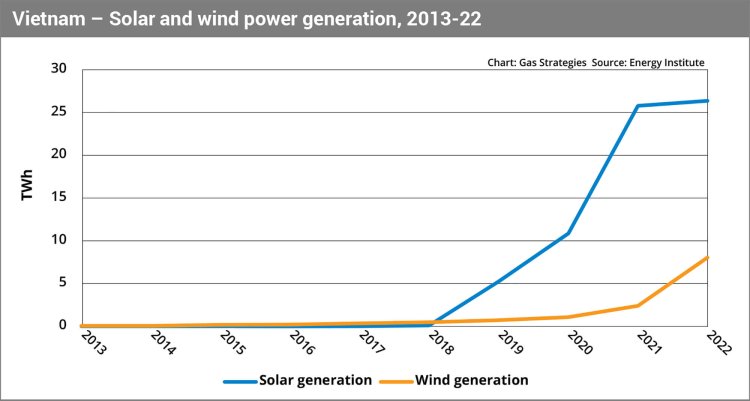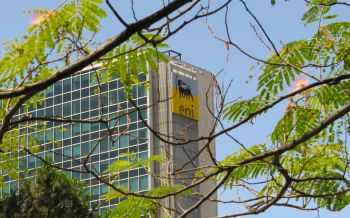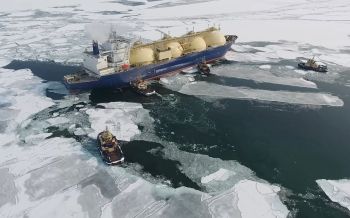- Vietnam seeks long-term LNG supplies after commissioning first import terminal with Shell-supplied cargo in July
- Rosy economic outlook and decarbonisation pathway prime Vietnam for extensive coal-to-gas switching this decade
- Plan for over a dozen LNG-to-power projects looks ambitious due to persistent downstream power tariff gridlock
- Hanoi’s reluctance to hike retail power tariffs could limit LNG just as renewable energy capacity build-up continues
Vietnam inaugurated its first LNG import terminal in late October, having received a commissioning cargo from Shell in July. The official launch of the 1 mtpa Thi Vai terminal marks a milestone in Vietnam’s longstanding dream to become an LNG importer, but Asia’s fastest-growing economy last year may not be able to unlock the full potential of its LNG imports until the second half of this decade amid substantial delays to other major projects and persistent volatility in global gas prices.
Vietnam joined the LNG importers club in July when its maiden cargo from Shell was unloaded at the USD 258 million Thi Vai terminal operated by state-owned PetroVietnam Gas (PV Gas) in Ba Rai-Vung Tau province in the south. Vietnam’s debut cargo arrived a few months after the Philippines started importing LNG, expanding the ranks of south-east Asian buyers beyond Thailand, Singapore, Indonesia and Malaysia.
South-east Asia has long been touted as a growth driver for global LNG, as a vibrant economic outlook for this decade coupled with decarbonisation goals spearhead demand for more clean energy. Nowhere is this more evident than Vietnam, which wants to clock annual average GDP growth of 7% this decade while peaking greenhouse gas (GHG) emissions by 2030 and then zeroing them out by mid-century. To this end, gas has been handed an expanded role in Vietnam’s electricity generation under the eighth national Power Development Plan (PDP8): the policy document, approved in late May after a number of delays, calls for gas/LNG-to-power to generate a quarter of Vietnam’s power by 2030.
Vietnam’s gas-fired plant fleet is currently comprised of ten plants with combined capacity of 7.18 GW. All are located in the south and fed by domestic gas fields, which supply all the gas Vietnam consumes. The country wants 13 new LNG-to-power plants totalling 22.4 GW of capacity up and running by 2030, and another two of 3.0 GW each online by 2035, to meet power demand in the north, north-central coast and south, according to PDP8.
PV Gas is also developing the USD 1.4 billion Son My LNG import terminal under a joint venture with US-based AES Corporation. The partners received investment policy approval from Binh Dinh province in July for the project, which will have first-phase capacity of 3.6 mtpa and feed AES’ USD 1.8 billion, 2.2 GW Son My 2 combined cycle gas turbine (CCGT) power plant.
Where’s the gas?
But last month’s landmark inauguration of the Thi Vai terminal belies the difficulties of integrating LNG into Vietnam’s fuel mix. Multiple LNG-to-power projects and regasification terminals were announced in recent years with the involvement of eager foreign investors, but disagreement over pricing, construction delays and lack of supply contracts have dogged Vietnam’s adoption of LNG, casting doubt over PDP8’s gas ambitions.
“We think the full potential of Vietnamese LNG demand may only be unlocked from 2025, given substantial delays to major projects and the current extreme volatility in global gas prices,” Min Na, head of Asia LNG at London-based Energy Aspects, tells LNG Business Review. “Additionally, no term LNG contracts have been signed by Vietnamese companies, making it challenging to import LNG solely under spot procurements given unfavourable economics.”
PV Gas said in March 2022 that it had signed eight master sales and purchase agreements (MSPAs) with undisclosed suppliers in preparation for the start-up of the Thi Vai terminal. But the sense among industry insiders is that these agreements will result in eight LNG cargoes in total, rather than eight separate long-term contracts for multiple cargoes.
PV Gas has not disclosed the timeline for importing these volumes, but following the delivery from Shell in July, the remaining seven cargoes are expected to be imported evenly over this year and next. It is unclear whether the eight MSPAs are binding or at what price they were agreed.
Vietnam appears to still be examining its long-term supply options. PV Gas said earlier this year it had held talks with ExxonMobil and Russia’s Novatek over LNG supplies to Vietnam, and after the arrival of the first cargo this summer, the company said it had “successfully undergone due diligence with other energy majors such as Cheniere, [QatarEnergy] and PetroChina with high credits.”
Regarding LNG suppliers, “Vietnam is still exploring, understandably with price and reliability the most important factor,” Giang Le, a Vietnam specialist at strategic consulting firm Control Risks, tells LNG Business Review.
“Barring a return of the Trump presidency – with its emphasis on trade deficit – it won’t really matter if the supplier is the US. Russian suppliers like Novatek will likely generate some hesitation at sanctions and tensions with the US,” Giang says.
But without long-term LNG supply, Vietnam will be exposed to volatile spot prices, with the JKM spiking to a record USD 70/MMBtu in August last year, compared to an average USD 16/MMBtu this past October. “Clearly, LNG is a type of resource that could make a real difference in Vietnam’s decarbonisation [but] price is the big concern and the key factor that determines if a project is feasible or not,” says Vinh Nguyen, senior manager at the recently opened Hanoi office of Asia energy consultancy The Lantau Group.
Infrastructure delays
Downstream developments to leverage the newly inaugurated Thi Vai terminal have reflected the difficulty of getting gas and power infrastructure up and running. The terminal is intended to supply regasified LNG to Units 3 and 4 of the Nhon Trach CCGT power plant, each with 750 MW of capacity, as well as industrial users in the Phy My industrial park through the Thi Vai-Phu My gas pipeline that was completed in December 2021.
At the terminal’s inauguration on 29 October, Vietnam’s deputy prime minister, Tran Luu Quang, urged PV Gas to expedite construction of the two LNG-fired units, which will be the first in Vietnam. Tran’s appeal reflects the drawn-out development of the two units: PV Power signed their engineering, procurement and construction (EPC) contract with Samsung C&T and local EPC contractor Lilama Corporation more than 18 months ago, in March 2022, but it is likely that the two units will not be ready until November 2024 and May 2025 – with implied gas burn at around one cargo per month for each unit, assuming a standard 68% utilisation rate.
Thi Vai will also supply regasified LNG to a planned industrial project owned by PV Chemical and Services and Thai Industrial Gas Company, but commissioning was delayed to June 2025 due to Covid-19 disruptions.
Coal-to-gas switching in electricity generation could have an immediate impact on Vietnam’s decarbonisation, but displacing the dominant fuel will take time. Coal contributed 46.3% of Vietnam’s power output in October compared with 27.7% for hydropower, 13.9% for solar and wind combined, 9.9% for gas and the remaining 2.1% from fuel oil and imports, according to state-owned Vietnam Electricity (EVN). In 2022, coal’s share stood at 39%, compared with 11% for gas, Energy Institute (EI) data shows.
Vietnam’s is currently home to 29 coal-fired power plants with a total capacity of 26.087 GW. Six more coal-fired plants are under construction and will be online by 2025-2026.
There is precedent for extended delays to the commissioning of LNG terminals in Vietnam. The 2-3 mtpa Hai Linh regasification terminal, owned by private company Hai Linh Energy, completed construction in 2020. Supposed to be Vietnam’s first regasification terminal, it has not undergone testing and commissioning yet.
Hai Linh Energy acquired the Hiep Phuoc power plant in 2019 and planned to resume operations at the three existing gas units, with a total capacity of 375 MW, and build a 810 MW LNG-fired unit. The Hai Linh terminal was expected to supply regasified LNG to the 1.2 GW Hiep Phuoc plant 15 km south-east of Ho Chi Minh City and the ENV Genco 3 plants, though the start-up of the Hiep Phuoc power plant was delayed again from summer 2022. Running this project, which was built at a cost of USD 900 million, would require ~ 80,000 tonnes of LNG per month. As it stands, it does not look as though the Hai Linh terminal will come online until 2025.
The persistent delays to regasification and gas-fired power infrastructure compare unfavourably with a growing renewable power development pipeline that leaves the outlook for gas unclear. Vietnam leads emerging markets in Asia Pacific when it comes to building renewable energy capacity, thanks to aggressive policies including feed-in tariffs to attract investment in solar and wind power.
With an eye on unleashing its technical as well as commercial potential for offshore wind power, Hanoi is now considering scaling up this particular sector to take advantage of the country’s 3,000 km coastline and the prospect of pairing turbines with electrolysers to produce green hydrogen.
Gas power tariff squeeze
The 15 LNG-to-power projects approved in PDP8 face multiple headwinds, with the most pressing being electricity tariffs in Vietnam. The problem stems from billion-dollar losses incurred by EVN on electricity sales: the power monopoly lost VND 28.7 trillion (USD 1.2 billion) in the first eight months of this year, already exceeding last year’s loss of VND 26.5 trillion.
“The most important reason why EVN has been making big financial losses is that it usually has to buy electricity from power plants at prices higher than the retail tariffs it is able to charge end-consumers, like industrial, commercial, household,” says Giang.
Power plants in Vietnam can either sell a share of their output at a fixed rate – called the contract quantity (QC) – to EVN, on the competitive wholesale electricity market, or a mix of both. EVN paid high wholesale prices last year because of expensive imported coal and the high feed-in tariff that Vietnam used to entice renewable energy developers in 2018-2021.
“Expensive imported coal prices translate to expensive electricity from coal plants. So EVN lost lots of money buying electricity from build-operate-transfer plants that have a cost pass-through mechanism and QC in their power purchase agreements,” explains Giang.
In May, Hanoi finally greenlit a 3% hike in retail power tariffs to reduce the burden on EVN, but the company’s average procurement price remains higher than its selling price. This could be a major problem going forward as the cost of electricity from the proposed fleet of LNG-fired power plants will also be high.
Vietnam’s existing gas-fired power fleet pays relatively low prices for domestically produced gas. The Nam Con Son-Cuu Long field presently produces 5 Bcm/year and sells to power plants at a citygate price of USD 8.5/MMBtu, while the Sao Vang Dai Nguyen field produces 1.5 Bcm/year that is sold at USD 9.8/MMBtu at the citygate. The Vietnam Energy Institute has forecast the citygate price from these fields to average USD 9.2/MMBtu by 2025.
Production from Vietnam’s two major gas fields that are under development, Block B and Ca Voi Xanh (Blue Whale), will be more expensive. Block B’s 5.06 Bcm/year output could cost USD 13.1/MMBtu in 2026, when the first of three 1.05 GW power plants using its gas starts up, while the 7-8 Bcm/year Blue Whale is projected at USD 11.25/MMBtu for five 750 MW plants beginning in 2028.
EVN is expected to suffer massive losses on the power purchase agreements (PPAs) it signs with these power plants, which need to cover their fuel costs. The lack of progress in PPA negotiations between the two sides has delayed upstream development of both projects, slowing their commercialisation.
Imported LNG could cost even more: in PDP8, prices are forecast to average USD 14/MMBtu in 2023-2025, before falling to USD 11.8-11.9/MMBtu. Meanwhile, a mechanism for passing through high gas costs will make LNG-derived electricity even more expensive in times of great price volatility.
“This is really hard to overcome. A pass-through to end-users would require higher electricity tariffs but the government is not willing to face an increase because it would reduce the competitiveness of Vietnam with other south-east Asian countries,” Nguyen says.
“While Vietnam views gas as a necessary baseload alternative to coal, LNG faces a lot of reluctance and hesitation. The government clearly prioritises the development of Block B and Blue Whale for energy security purpose,” says Giang. He adds it will probably take a much bleaker prognosis of power shortages to galvanise authorities to hike retail tariffs to accommodate more expensive gas-derived electricity, and permit contractual clauses demanded by LNG developers, such as QC, take-or-pay, and pass-through.
“I think government leaders really hope and pray that domestic gas fields, plus imports from Laos, plus renewables with commercially viable energy storage solutions, along with a few new coal plants and additional hydropower, will be enough. This stance makes it questionable whether all 15 LNG-to-power projects listed in PDP8 can go ahead,” concludes Giang. - JX
Subscription Benefits
Our three titles – LNG Business Review, Gas Matters and Gas Matters Today – tackle the biggest questions on global developments and major industry trends through a mixture of news, profiles and analysis.
LNG Business Review
LNG Business Review seeks to discover new truths about today’s LNG industry. It strives to widen market players’ scope of reference by actively engaging with events, offering new perspectives while challenging existing ones, and never shying away from being a platform for debate.
Gas Matters
Gas Matters digs deep into the stories of today, keeping the challenges of tomorrow in its sights. Weekly features and interviews, informed by unrivalled in-house expertise, offer a fresh perspective on events as well as thoughtful, intelligent analysis that dares to challenge the status quo.
Gas Matters Today
Gas Matters Today cuts through the bluster of online news and views to offer trustworthy, informed perspectives on major events shaping the gas and LNG industries. This daily news service provides unparalleled insight by drawing on the collective knowledge of in-house reporters, specialist contributors and extensive archive to go beyond the headlines, making it essential reading for gas industry professionals.



